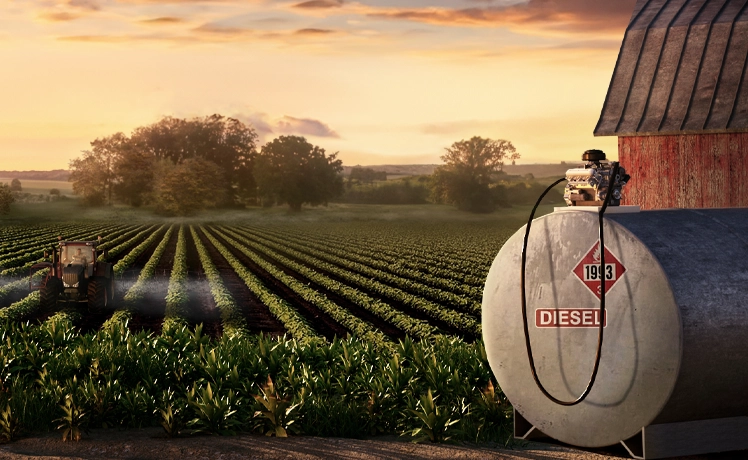
11/20/24
By Erika Howes
In the world of diesel engines, fuel quality plays a crucial role in performance, efficiency, and longevity. But many truck drivers know that not all diesel fuel is created alike.
Understanding the various types of diesel fuels and their distinct characteristics can help you make informed choices. Whether you’re a fleet manager, a truck owner, or simply curious about what powers our modern vehicles, understanding and selecting the right diesel fuel for your vehicle is make or break.
Read on as we delve into the nuances of diesel fuel quality so you can better understand your fuel and how best to care for it.

So, what is quality diesel fuel? Diesel fuel quality refers to the fuel’s performance and can be gauged by how well it combusts and protects engine parts. Several factors can influence the quality of diesel fuel including how clean it is, what types of additives it contains, and how it is stored.

A fuel’s cetane number is one way to measure its quality. The cetane number reflects how quickly the fuel ignites and burns. The higher the cetane number, the faster the fuel ignites. Most fuel in the US contains a cetane number between 40 and 55.
It is important not to exceed the recommended range of cetane in fuel. Doing so can cause the fuel to combust too quickly in the engine and cause damage. Cetane numbers above 55 can actually deteriorate fuel and decrease overall performance.
Premium diesel may contain additional additives engineered to improve the performance of your engine. You can also add these types of additives yourself to increase the quality and stability of your fuel.
The storage of diesel is also very important to its quality. When contaminants are introduced to stored fuel, they can rapidly degrade how well it performs in your vehicle. It’s important to keep your fuel free of water, sediment, and other microbial content.
Testing your diesel can prove very useful in extending the life of your fuel and your engine. Ensuring you are using the best quality diesel fuel will save you time and money by increasing fuel economy, extending equipment longevity, and reducing excess maintenance.

There are several different types and grades of diesel fuels available. Each has its own set of benefits and drawbacks. Some of the types most typically used in everyday vehicles and equipment include:
By 2014, virtually all petroleum-based diesel available in the US was mandated to be Ultra Low Sulfur Diesel (ULSD). That means the diesel must have a sulfur content of less than 15 parts per million (ppm) in order to reduce harmful emissions from diesel combustion.
While better for the environment, ULSD is detrimental to engines. The lack of sulfur reduces the fuel's lubricity, which can lead to parts drying out and damage to the fuel system.
Though biodiesel provides a cleaner alternative for the environment, it still contains impurities, and dirty fuel can cause problems in the engine.

Another drawback of biodiesel is its difficulty in storing. With its higher water content, storing biodiesel in temperatures that are too warm can cause microbial growth. Storing it in temperatures too cold can cause thickening far sooner than with regular petroleum diesel.
The availability of certain diesels across the US can also vary. While standard diesels like Diesel #1 and Diesel #2 are widely available across the US, it may be more difficult to find Diesel #1 in warmer regions. Diesel fuel types and availability may vary based on regional climate and time of year.
Biodiesel is mandated for use at certain levels in different states throughout the country. For example, Pennsylvania requires a 2% biodiesel blend in every gallon of on-road diesel fuel. Meanwhile, Minnesota requires a 20% blend during the months of April through September, but only a 5% blend the rest of the year.
Renewable diesels are still primarily based on the West Coast. They can be found mainly in California, Washington, and Oregon, where clean fuel programs incentivize their consumption.
It is important to understand different types of diesel fuel and when you should use them. When trying to distinguish between the two standard types of diesel fuelfuels, Diesel #1 and Diesel 2, weather plays a key role.
Viscosity, or a fuel’s state of thickness, determines how easily the fuel flows. Higher viscosity can provide better lubrication and more energy. Lower viscosity can flow easier, especially in colder temperatures, leading to less hard starts.

Diesel #1 has a lower viscosity level and, therefore, performs better in colder climates. It often contains more cetane, allowing it to ignite more quickly. However, it is more flammable and has less energy content.
Diesel #2 has a higher viscosity level and packs more energy content. It is perfect for powering heavy-duty vehicles and machinery, especially in warm temperatures. #2 Diesel is also more widely available and generally more cost-effective.
The difference between 1 and 2 diesel fuel comes into play mostly based on weather. During the winter months, you may find a blend of the two fuels, often referred to as Winterized Diesel. Blending the fuels can help prevent the gelling of Diesel #2 on its own.
The differences in diesel fuel quality between the two types depend on what is most important for your operating conditions. Both may require performance-boosting additives. However, Diesel #1 may already contain more additives than Diesel #2, adding to its higher cost. On average, Diesel #2 is well-suited for use in a wide variety of vehicles and equipment. When cold weather sets in, mixing in some Diesel #1 may be a good addition on top of adding an anti-gel.
Choosing which diesel fuel to use should come down to more than just price point alone. While the cost of the fuel you buy is important, there are other factors that should be considered as well.

It is important to find a reputable supplier for your diesel fuel. You want to look for consistent diesel fuel quality whether you have your fuel delivered or you fill up at the pump. The best quality diesel fuel is clean, free of water, and properly stored.
While diesel fuel specifications may vary by region and application, there are general standards set in America by ASTM International (formerly known as American Society for Testing and Materials) and the EPA (Environmental Protection Agency). These include Biodiesel Blends and Ultra Low Sulfur Diesel.
There are also different fuels designed for specific applications and certain types of engines. These include Jet Fuel, Marine Diesel, and Off-Road Diesel. Jet Fuel is similar to kerosene. Marine Diesel, which is often used for large ships, can vary in sulfur content as well as other properties. Off-Road Diesel is used mainly in construction and industrial machinery but can be used in agricultural applications as well.
Now that ULSD is mandated nationwide, the main difference between on-road and off-road diesel is color. On-road diesel is taxed to help support road infrastructure. Off-road diesel is exempt from the tax but is dyed red to make it easily identifiable. Trying to avoid taxed fuel can lead to serious fines and even jail time.
When choosing between the different types of diesel fuel available for your engine, keep in mind things like cetane number, viscosity, and cold flow properties. You want your fuel to have enough energy to power your vehicle properly but also flow well enough to work in a variety of temperatures.

The quality of diesel fuel plays a big role in engine performance and can affect overall maintenance costs. High-quality fuel allows for smoother operation, increased fuel economy, and reduced wear on system components. Low-quality fuel can cause poor engine performance and lead to unnecessary maintenance increases. Clean fuel combined with quality fuel additives can keep your engine performing better for longer in all types of applications.